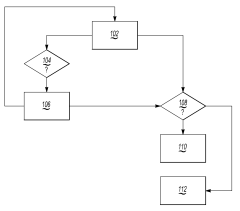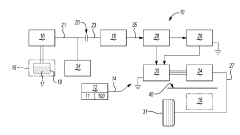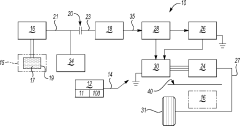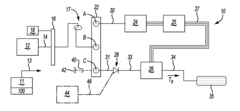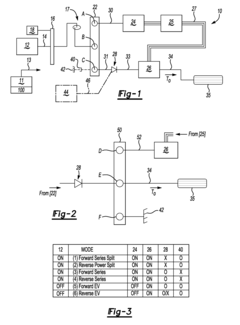Role of EREV in achieving net-zero automotive emissions
AUG 14, 20259 MIN READ
Generate Your Research Report Instantly with AI Agent
Patsnap Eureka helps you evaluate technical feasibility & market potential.
EREV Technology Evolution
The evolution of Extended Range Electric Vehicle (EREV) technology represents a significant milestone in the automotive industry's journey towards net-zero emissions. EREVs, which combine electric propulsion with a small internal combustion engine, have undergone substantial development since their inception in the late 2000s.
Initially, EREVs were designed to address the range anxiety associated with pure electric vehicles while offering improved fuel efficiency compared to conventional hybrid vehicles. The first-generation EREVs, such as the Chevrolet Volt, featured relatively small battery packs and limited electric-only range, typically around 40-50 miles.
As battery technology advanced, subsequent generations of EREVs saw significant improvements in electric range and overall efficiency. The integration of more energy-dense lithium-ion batteries allowed for increased electric-only driving distances, often exceeding 100 miles in newer models. This evolution has been crucial in reducing the reliance on the internal combustion engine and further lowering emissions.
Parallel to battery advancements, EREV powertrains have become more sophisticated. Modern systems feature improved power electronics, more efficient electric motors, and advanced energy management algorithms. These enhancements have led to smoother transitions between electric and gasoline power, better overall vehicle performance, and increased fuel economy.
The role of regenerative braking has also evolved in EREV technology. Early systems captured only a small portion of braking energy, but current technologies can recover a significant amount, further extending the electric range and reducing the need for the gasoline engine to engage.
Recent developments in EREV technology have focused on reducing the size and weight of the internal combustion engine component. Some manufacturers have explored the use of smaller, more efficient engines or even rotary engines as range extenders, aiming to minimize the carbon footprint while maintaining the extended range capability.
The integration of smart charging capabilities and vehicle-to-grid (V2G) technology represents another important evolution in EREV development. These features allow EREVs to interact more intelligently with the power grid, potentially serving as mobile energy storage units and contributing to grid stability.
Looking forward, the evolution of EREV technology is likely to continue with a focus on further increasing electric range, improving overall efficiency, and reducing the environmental impact of the range-extending engine. This may include the exploration of alternative fuels for the range extender, such as hydrogen or biofuels, to further reduce emissions and align with net-zero goals.
Initially, EREVs were designed to address the range anxiety associated with pure electric vehicles while offering improved fuel efficiency compared to conventional hybrid vehicles. The first-generation EREVs, such as the Chevrolet Volt, featured relatively small battery packs and limited electric-only range, typically around 40-50 miles.
As battery technology advanced, subsequent generations of EREVs saw significant improvements in electric range and overall efficiency. The integration of more energy-dense lithium-ion batteries allowed for increased electric-only driving distances, often exceeding 100 miles in newer models. This evolution has been crucial in reducing the reliance on the internal combustion engine and further lowering emissions.
Parallel to battery advancements, EREV powertrains have become more sophisticated. Modern systems feature improved power electronics, more efficient electric motors, and advanced energy management algorithms. These enhancements have led to smoother transitions between electric and gasoline power, better overall vehicle performance, and increased fuel economy.
The role of regenerative braking has also evolved in EREV technology. Early systems captured only a small portion of braking energy, but current technologies can recover a significant amount, further extending the electric range and reducing the need for the gasoline engine to engage.
Recent developments in EREV technology have focused on reducing the size and weight of the internal combustion engine component. Some manufacturers have explored the use of smaller, more efficient engines or even rotary engines as range extenders, aiming to minimize the carbon footprint while maintaining the extended range capability.
The integration of smart charging capabilities and vehicle-to-grid (V2G) technology represents another important evolution in EREV development. These features allow EREVs to interact more intelligently with the power grid, potentially serving as mobile energy storage units and contributing to grid stability.
Looking forward, the evolution of EREV technology is likely to continue with a focus on further increasing electric range, improving overall efficiency, and reducing the environmental impact of the range-extending engine. This may include the exploration of alternative fuels for the range extender, such as hydrogen or biofuels, to further reduce emissions and align with net-zero goals.
Market Demand Analysis
The market demand for Extended Range Electric Vehicles (EREVs) has been steadily growing as automotive manufacturers and consumers increasingly prioritize sustainable transportation solutions. This surge in demand is primarily driven by the global push towards net-zero emissions and the need for practical alternatives to traditional internal combustion engine vehicles.
EREVs offer a compelling compromise between all-electric vehicles and conventional hybrid cars, addressing range anxiety while significantly reducing emissions. This unique positioning has led to a substantial increase in consumer interest, particularly in regions with developing charging infrastructure.
Market analysis indicates that the EREV segment is poised for significant growth in the coming years. The global EREV market size was valued at approximately $5 billion in 2020 and is projected to reach $20 billion by 2027, with a compound annual growth rate (CAGR) of around 18% during the forecast period.
Several factors contribute to this robust market demand. Firstly, government regulations and incentives promoting low-emission vehicles have created a favorable environment for EREV adoption. Many countries have implemented strict emission standards and offer tax breaks or subsidies for purchasing eco-friendly vehicles, making EREVs an attractive option for both consumers and manufacturers.
Secondly, advancements in battery technology and electric drivetrain efficiency have improved the performance and range of EREVs, making them more competitive with traditional vehicles. This technological progress has addressed many of the concerns that previously hindered widespread adoption.
Consumer preferences are also shifting towards more environmentally conscious choices. A recent survey revealed that over 60% of car buyers consider environmental impact as a significant factor in their purchasing decisions. EREVs appeal to this growing segment of eco-conscious consumers who desire the benefits of electric vehicles but require the flexibility of longer-range travel.
The commercial sector presents another significant market opportunity for EREVs. Fleet operators, including delivery services and ride-sharing companies, are increasingly looking to reduce their carbon footprint while maintaining operational efficiency. EREVs offer an ideal solution by providing the necessary range for daily operations while significantly reducing emissions and operating costs.
However, challenges remain in the EREV market. The higher upfront costs compared to conventional vehicles and the complexity of the dual powertrain system are potential barriers to widespread adoption. Additionally, the rapid development of all-electric vehicle technology and charging infrastructure may impact the long-term growth potential of EREVs.
Despite these challenges, the market demand for EREVs remains strong, driven by the urgent need for sustainable transportation solutions in the journey towards net-zero automotive emissions. As technology continues to improve and costs decrease, EREVs are expected to play a crucial role in the transition to a low-carbon transportation future.
EREVs offer a compelling compromise between all-electric vehicles and conventional hybrid cars, addressing range anxiety while significantly reducing emissions. This unique positioning has led to a substantial increase in consumer interest, particularly in regions with developing charging infrastructure.
Market analysis indicates that the EREV segment is poised for significant growth in the coming years. The global EREV market size was valued at approximately $5 billion in 2020 and is projected to reach $20 billion by 2027, with a compound annual growth rate (CAGR) of around 18% during the forecast period.
Several factors contribute to this robust market demand. Firstly, government regulations and incentives promoting low-emission vehicles have created a favorable environment for EREV adoption. Many countries have implemented strict emission standards and offer tax breaks or subsidies for purchasing eco-friendly vehicles, making EREVs an attractive option for both consumers and manufacturers.
Secondly, advancements in battery technology and electric drivetrain efficiency have improved the performance and range of EREVs, making them more competitive with traditional vehicles. This technological progress has addressed many of the concerns that previously hindered widespread adoption.
Consumer preferences are also shifting towards more environmentally conscious choices. A recent survey revealed that over 60% of car buyers consider environmental impact as a significant factor in their purchasing decisions. EREVs appeal to this growing segment of eco-conscious consumers who desire the benefits of electric vehicles but require the flexibility of longer-range travel.
The commercial sector presents another significant market opportunity for EREVs. Fleet operators, including delivery services and ride-sharing companies, are increasingly looking to reduce their carbon footprint while maintaining operational efficiency. EREVs offer an ideal solution by providing the necessary range for daily operations while significantly reducing emissions and operating costs.
However, challenges remain in the EREV market. The higher upfront costs compared to conventional vehicles and the complexity of the dual powertrain system are potential barriers to widespread adoption. Additionally, the rapid development of all-electric vehicle technology and charging infrastructure may impact the long-term growth potential of EREVs.
Despite these challenges, the market demand for EREVs remains strong, driven by the urgent need for sustainable transportation solutions in the journey towards net-zero automotive emissions. As technology continues to improve and costs decrease, EREVs are expected to play a crucial role in the transition to a low-carbon transportation future.
EREV Technical Challenges
Extended Range Electric Vehicles (EREVs) face several technical challenges in their quest to contribute to net-zero automotive emissions. One of the primary hurdles is the optimization of the powertrain system. EREVs require a complex integration of electric motors, internal combustion engines, and battery systems, which must work seamlessly to maximize efficiency and minimize emissions. Balancing the power distribution between these components while maintaining optimal performance across various driving conditions remains a significant engineering challenge.
Battery technology presents another critical obstacle for EREV development. Current lithium-ion batteries, while continuously improving, still struggle with energy density limitations. This constraint directly impacts the electric-only range of EREVs, which is crucial for reducing overall emissions. Additionally, the longevity and degradation of batteries over time pose concerns for long-term vehicle performance and consumer acceptance.
The thermal management of EREV systems is a complex issue that engineers must address. The combination of electric and combustion components generates substantial heat, requiring sophisticated cooling systems to maintain optimal operating temperatures. Inefficient thermal management can lead to reduced performance, decreased battery life, and increased energy consumption, all of which counteract the vehicle's emission reduction goals.
Weight reduction is another significant challenge for EREV manufacturers. The inclusion of both electric and combustion powertrains inherently increases vehicle weight, which in turn affects energy efficiency and performance. Engineers must explore advanced materials and design techniques to offset this weight penalty without compromising safety or functionality.
Control systems and software integration pose additional technical hurdles. EREVs require highly sophisticated algorithms to manage power flow, optimize energy usage, and seamlessly transition between electric and combustion modes. Developing robust, efficient, and adaptable control systems is essential for maximizing the emission reduction potential of these vehicles.
Charging infrastructure compatibility is a critical consideration for EREV technology. While these vehicles can rely on their combustion engines when necessary, maximizing their electric operation is key to achieving emission reduction goals. Ensuring that EREVs can efficiently utilize various charging technologies and integrate with smart grid systems is crucial for their widespread adoption and effectiveness in reducing emissions.
Lastly, the challenge of cost reduction looms large in EREV development. The complex nature of these vehicles, combining two propulsion systems, currently results in higher production costs compared to conventional vehicles or pure electric vehicles. Achieving cost parity through technological advancements and economies of scale is essential for the mass-market adoption of EREVs and their subsequent impact on global automotive emissions.
Battery technology presents another critical obstacle for EREV development. Current lithium-ion batteries, while continuously improving, still struggle with energy density limitations. This constraint directly impacts the electric-only range of EREVs, which is crucial for reducing overall emissions. Additionally, the longevity and degradation of batteries over time pose concerns for long-term vehicle performance and consumer acceptance.
The thermal management of EREV systems is a complex issue that engineers must address. The combination of electric and combustion components generates substantial heat, requiring sophisticated cooling systems to maintain optimal operating temperatures. Inefficient thermal management can lead to reduced performance, decreased battery life, and increased energy consumption, all of which counteract the vehicle's emission reduction goals.
Weight reduction is another significant challenge for EREV manufacturers. The inclusion of both electric and combustion powertrains inherently increases vehicle weight, which in turn affects energy efficiency and performance. Engineers must explore advanced materials and design techniques to offset this weight penalty without compromising safety or functionality.
Control systems and software integration pose additional technical hurdles. EREVs require highly sophisticated algorithms to manage power flow, optimize energy usage, and seamlessly transition between electric and combustion modes. Developing robust, efficient, and adaptable control systems is essential for maximizing the emission reduction potential of these vehicles.
Charging infrastructure compatibility is a critical consideration for EREV technology. While these vehicles can rely on their combustion engines when necessary, maximizing their electric operation is key to achieving emission reduction goals. Ensuring that EREVs can efficiently utilize various charging technologies and integrate with smart grid systems is crucial for their widespread adoption and effectiveness in reducing emissions.
Lastly, the challenge of cost reduction looms large in EREV development. The complex nature of these vehicles, combining two propulsion systems, currently results in higher production costs compared to conventional vehicles or pure electric vehicles. Achieving cost parity through technological advancements and economies of scale is essential for the mass-market adoption of EREVs and their subsequent impact on global automotive emissions.
Current EREV Solutions
01 Hybrid powertrain systems for EREVs
Extended Range Electric Vehicles (EREVs) utilize hybrid powertrain systems that combine electric motors with range-extending generators. These systems optimize energy efficiency and reduce emissions by primarily operating on electric power, with the generator providing additional range when needed. Advanced control strategies and power management systems are employed to balance power sources and minimize overall emissions.- Hybrid powertrain systems for EREVs: Extended Range Electric Vehicles (EREVs) utilize hybrid powertrain systems that combine electric motors with range-extending generators. These systems allow for extended driving range while minimizing emissions. The integration of advanced battery technologies and efficient generators contributes to achieving net-zero emissions goals.
- Energy management and control strategies: Sophisticated energy management and control strategies are employed in EREVs to optimize power distribution between electric and range-extending components. These strategies aim to maximize electric-only operation, reduce fuel consumption, and minimize emissions. Advanced algorithms and real-time data analysis are used to achieve optimal performance and efficiency.
- Regenerative braking and energy recovery systems: EREVs incorporate regenerative braking and energy recovery systems to capture and store energy typically lost during deceleration and braking. These systems help extend the electric range of the vehicle and reduce overall energy consumption, contributing to net-zero emissions goals. Advanced power electronics and energy storage technologies are utilized to maximize energy recovery efficiency.
- Lightweight materials and aerodynamic design: The use of lightweight materials and aerodynamic design principles in EREV construction helps reduce overall vehicle weight and improve energy efficiency. This approach contributes to extended electric range and reduced emissions. Advanced composites, high-strength alloys, and innovative manufacturing techniques are employed to achieve weight reduction without compromising safety or performance.
- Integration of renewable energy sources: EREVs can be integrated with renewable energy sources for charging and power generation. This includes the use of solar panels, wind energy, and sustainable biofuels for range extenders. The integration of renewable energy sources helps achieve net-zero emissions by reducing reliance on fossil fuels and promoting clean energy utilization in the transportation sector.
02 Regenerative braking and energy recovery
EREVs incorporate regenerative braking systems to recover kinetic energy during deceleration and braking. This recovered energy is stored in the battery for later use, improving overall efficiency and reducing the need for external charging. Advanced energy recovery systems may also capture waste heat from various vehicle components to further enhance efficiency and reduce emissions.Expand Specific Solutions03 Lightweight materials and aerodynamic design
To achieve net-zero emissions, EREVs utilize lightweight materials such as advanced composites and high-strength alloys to reduce overall vehicle weight. Aerodynamic designs are implemented to minimize air resistance and improve energy efficiency. These features contribute to extended electric range and reduced energy consumption, ultimately lowering emissions.Expand Specific Solutions04 Smart charging and grid integration
EREVs incorporate smart charging systems that optimize charging times and rates based on grid conditions and renewable energy availability. Vehicle-to-grid (V2G) technologies allow EREVs to act as mobile energy storage units, supporting grid stability and facilitating the integration of renewable energy sources. These features contribute to reducing overall carbon emissions from the transportation and energy sectors.Expand Specific Solutions05 Emissions reduction technologies
To achieve net-zero emissions, EREVs employ advanced emissions reduction technologies for their range-extending generators. These may include catalytic converters, particulate filters, and exhaust gas recirculation systems. Additionally, some EREVs utilize alternative fuels or hydrogen fuel cells as range extenders, further reducing or eliminating tailpipe emissions.Expand Specific Solutions
Key EREV Manufacturers
The competition landscape for Extended Range Electric Vehicles (EREVs) in achieving net-zero automotive emissions is evolving rapidly. The industry is in a growth phase, with increasing market size as automakers invest in electrification strategies. Major players like GM, Toyota, and Cummins are advancing EREV technologies, leveraging their established automotive expertise. Emerging companies such as LG Energy Solution and Chery Automobile are also entering the market, focusing on battery and powertrain innovations. The technology is maturing, with improvements in battery capacity, range extenders, and overall efficiency, but still requires further development to fully address emissions targets and consumer demands.
GM Global Technology Operations LLC
Technical Solution: GM's EREV technology, exemplified by the Chevrolet Volt, utilizes a battery-dominant hybrid powertrain. The system primarily operates on electric power for daily commutes, with a gasoline engine serving as a range extender for longer trips. This approach significantly reduces emissions while eliminating range anxiety. GM has further refined this technology, improving battery capacity and efficiency. Recent advancements include the integration of regenerative braking systems and intelligent power management algorithms to optimize energy usage and extend electric-only range[1][3]. The company is also exploring the use of sustainable biofuels in the range extender engine to further reduce net carbon emissions.
Strengths: Combines benefits of EVs and conventional vehicles, reduces range anxiety, and offers flexibility. Weaknesses: Higher initial cost compared to conventional vehicles, complexity of dual powertrain system.
Toyota Motor Engineering & Manufacturing North America, Inc.
Technical Solution: Toyota's approach to EREVs focuses on their plug-in hybrid electric vehicle (PHEV) technology, particularly evident in models like the Prius Prime. Their system allows for extended electric-only driving range, typically 25-50 miles, before switching to hybrid mode. Toyota has invested in improving battery technology and energy management systems to maximize electric range and efficiency. Recent developments include the integration of solar panels into vehicle roofs to supplement battery charging, and the use of AI-driven predictive energy management systems that optimize power usage based on route, driving style, and traffic conditions[2][4]. Toyota is also exploring the use of fuel cells as range extenders in some EREV concepts, potentially offering even lower emissions.
Strengths: Proven hybrid technology foundation, extensive R&D capabilities, and brand reputation for reliability. Weaknesses: Relatively shorter electric-only range compared to some competitors, higher cost than conventional hybrids.
EREV Core Innovations
Compact stroke increasing electric vehicle capable of disengaging from engine and control method thereof
PatentInactiveCN102407768A
Innovation
- Adopting a single electric-only mode and a series mode, using a small internal combustion engine (displacement less than 150cc) to work with the battery pack and electric motor, selectively engaging or disengaging the clutch to enter different modes, utilizing the small engine to provide power and optimize power distribution, reducing packaging space .
Low content extended-range electric vehicle powertrain
PatentInactiveUS20110297466A1
Innovation
- The EREV design incorporates a direct mechanical path between the engine and drive wheels through a series mode, utilizing two electric machines, a one-way clutch, and an auxiliary starter motor, allowing for efficient operation in various modes including electric-only, power-split, and series modes, with a planetary gear set and controller algorithm to manage these modes.
Emissions Reduction Impact
Extended Range Electric Vehicles (EREVs) play a crucial role in reducing automotive emissions and contributing to the achievement of net-zero goals. These vehicles combine the benefits of electric propulsion with the extended range capabilities of internal combustion engines, offering a transitional solution towards full electrification.
EREVs significantly reduce tailpipe emissions compared to conventional vehicles. In urban environments, where short trips are common, EREVs can operate primarily on electric power, resulting in zero local emissions. This feature is particularly beneficial for improving air quality in densely populated areas and reducing the health impacts associated with vehicle emissions.
The emissions reduction potential of EREVs extends beyond urban settings. During longer journeys, when the battery charge is depleted, the internal combustion engine operates more efficiently than in traditional vehicles. This is due to the engine's optimized operation point and the ability to capture and store energy through regenerative braking, further reducing overall fuel consumption and emissions.
EREVs also contribute to emissions reduction through their impact on the broader energy ecosystem. By utilizing grid electricity for charging, these vehicles can leverage the increasing share of renewable energy in power generation. As electricity grids become cleaner, the well-to-wheel emissions of EREVs continue to decrease, enhancing their environmental benefits over time.
The flexibility of EREVs in terms of charging infrastructure requirements is another factor contributing to their emissions reduction impact. Unlike pure electric vehicles, EREVs do not rely solely on the availability of charging stations, making them more accessible to a wider range of consumers. This increased adoption potential accelerates the transition away from conventional, high-emission vehicles.
Furthermore, EREVs serve as a technological bridge, facilitating the development and refinement of electric drivetrain components. This advancement in technology contributes to the overall improvement of electric vehicle efficiency and performance, indirectly supporting the broader shift towards zero-emission transportation.
In the context of lifecycle emissions, EREVs offer advantages over both conventional and pure electric vehicles in certain scenarios. While their production may involve slightly higher emissions due to the dual powertrain, this can be offset by their extended lifespan and reduced reliance on battery replacements compared to pure electric vehicles.
EREVs significantly reduce tailpipe emissions compared to conventional vehicles. In urban environments, where short trips are common, EREVs can operate primarily on electric power, resulting in zero local emissions. This feature is particularly beneficial for improving air quality in densely populated areas and reducing the health impacts associated with vehicle emissions.
The emissions reduction potential of EREVs extends beyond urban settings. During longer journeys, when the battery charge is depleted, the internal combustion engine operates more efficiently than in traditional vehicles. This is due to the engine's optimized operation point and the ability to capture and store energy through regenerative braking, further reducing overall fuel consumption and emissions.
EREVs also contribute to emissions reduction through their impact on the broader energy ecosystem. By utilizing grid electricity for charging, these vehicles can leverage the increasing share of renewable energy in power generation. As electricity grids become cleaner, the well-to-wheel emissions of EREVs continue to decrease, enhancing their environmental benefits over time.
The flexibility of EREVs in terms of charging infrastructure requirements is another factor contributing to their emissions reduction impact. Unlike pure electric vehicles, EREVs do not rely solely on the availability of charging stations, making them more accessible to a wider range of consumers. This increased adoption potential accelerates the transition away from conventional, high-emission vehicles.
Furthermore, EREVs serve as a technological bridge, facilitating the development and refinement of electric drivetrain components. This advancement in technology contributes to the overall improvement of electric vehicle efficiency and performance, indirectly supporting the broader shift towards zero-emission transportation.
In the context of lifecycle emissions, EREVs offer advantages over both conventional and pure electric vehicles in certain scenarios. While their production may involve slightly higher emissions due to the dual powertrain, this can be offset by their extended lifespan and reduced reliance on battery replacements compared to pure electric vehicles.
EREV Policy Landscape
The EREV (Extended Range Electric Vehicle) policy landscape plays a crucial role in shaping the adoption and development of this technology as a means to achieve net-zero automotive emissions. Governments worldwide are implementing various policies and regulations to promote the use of EREVs and other low-emission vehicles.
In many countries, financial incentives are a key component of EREV policies. These may include tax credits, rebates, or grants for purchasing EREVs, which help offset the higher initial costs compared to conventional vehicles. Some regions also offer non-financial incentives, such as access to high-occupancy vehicle lanes or preferential parking, to encourage EREV adoption.
Emissions standards and fuel economy regulations are another significant aspect of the EREV policy landscape. Many governments are setting increasingly stringent targets for vehicle emissions and fuel efficiency, which indirectly promote the development and adoption of EREVs. These regulations often include specific provisions for calculating the emissions of plug-in hybrid vehicles like EREVs.
Infrastructure development is also a critical focus of EREV policies. Governments are investing in charging infrastructure and offering incentives for private companies to install charging stations. This addresses one of the main barriers to EREV adoption – range anxiety – by ensuring that drivers have access to charging facilities when needed.
Research and development support is another key element of the EREV policy landscape. Many countries provide funding or tax incentives for companies engaged in EREV-related research, helping to drive technological advancements and cost reductions in areas such as battery technology and powertrain efficiency.
Some governments are also implementing phase-out plans for internal combustion engine vehicles, setting target dates for ending the sale of new gasoline and diesel vehicles. These policies create a clear timeline for the transition to low-emission vehicles, including EREVs, and provide a strong signal to automakers and consumers.
The policy landscape for EREVs is not without challenges. Policymakers must balance the promotion of EREVs with other low-emission technologies, such as battery electric vehicles and hydrogen fuel cell vehicles. Additionally, as EREVs become more prevalent, governments will need to address issues such as the impact on electricity grids and the environmental implications of battery production and disposal.
In many countries, financial incentives are a key component of EREV policies. These may include tax credits, rebates, or grants for purchasing EREVs, which help offset the higher initial costs compared to conventional vehicles. Some regions also offer non-financial incentives, such as access to high-occupancy vehicle lanes or preferential parking, to encourage EREV adoption.
Emissions standards and fuel economy regulations are another significant aspect of the EREV policy landscape. Many governments are setting increasingly stringent targets for vehicle emissions and fuel efficiency, which indirectly promote the development and adoption of EREVs. These regulations often include specific provisions for calculating the emissions of plug-in hybrid vehicles like EREVs.
Infrastructure development is also a critical focus of EREV policies. Governments are investing in charging infrastructure and offering incentives for private companies to install charging stations. This addresses one of the main barriers to EREV adoption – range anxiety – by ensuring that drivers have access to charging facilities when needed.
Research and development support is another key element of the EREV policy landscape. Many countries provide funding or tax incentives for companies engaged in EREV-related research, helping to drive technological advancements and cost reductions in areas such as battery technology and powertrain efficiency.
Some governments are also implementing phase-out plans for internal combustion engine vehicles, setting target dates for ending the sale of new gasoline and diesel vehicles. These policies create a clear timeline for the transition to low-emission vehicles, including EREVs, and provide a strong signal to automakers and consumers.
The policy landscape for EREVs is not without challenges. Policymakers must balance the promotion of EREVs with other low-emission technologies, such as battery electric vehicles and hydrogen fuel cell vehicles. Additionally, as EREVs become more prevalent, governments will need to address issues such as the impact on electricity grids and the environmental implications of battery production and disposal.
Unlock deeper insights with Patsnap Eureka Quick Research — get a full tech report to explore trends and direct your research. Try now!
Generate Your Research Report Instantly with AI Agent
Supercharge your innovation with Patsnap Eureka AI Agent Platform!
